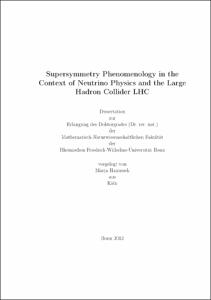Hanussek, Marja: Supersymmetry Phenomenology in the Context of Neutrino Physics and the Large Hadron Collider LHC. - Bonn, 2012. - Dissertation, Rheinische Friedrich-Wilhelms-Universität Bonn.
Online-Ausgabe in bonndoc: https://nbn-resolving.org/urn:nbn:de:hbz:5n-29801
Online-Ausgabe in bonndoc: https://nbn-resolving.org/urn:nbn:de:hbz:5n-29801
@phdthesis{handle:20.500.11811/5384,
urn: https://nbn-resolving.org/urn:nbn:de:hbz:5n-29801,
author = {{Marja Hanussek}},
title = {Supersymmetry Phenomenology in the Context of Neutrino Physics and the Large Hadron Collider LHC},
school = {Rheinische Friedrich-Wilhelms-Universität Bonn},
year = 2012,
month = sep,
note = {Experimentally, it is well established that the Standard Model of particle physics requires an extension to accommodate the neutrino oscillation data, which indicates that at least two neutrinos are massive and that two of the neutrino mixing angles are large. Massive neutrinos are naturally present in a supersymmetric extension of the Standard Model which includes lepton-number violating terms (the B3 MSSM). Furthermore, supersymmetry stabilizes the hierarchy between the electroweak scale and the scale of unified theories or the Planck scale. In this thesis, we study in detail how neutrino masses are generated in the B3 MSSM. We present a mechanism how the experimental neutrino oscillation data can be realized in this framework. Then we discuss how recently published data from the Large Hadron Collider (LHC) can be used to constrain the parameter space of this model. Furthermore, we present work on supersymmetric models where R-parity is conserved, considering scenarios with light stops in the light of collider physics and scenarios with near-massless neutralinos in connection with cosmological restrictions.},
url = {https://hdl.handle.net/20.500.11811/5384}
}
urn: https://nbn-resolving.org/urn:nbn:de:hbz:5n-29801,
author = {{Marja Hanussek}},
title = {Supersymmetry Phenomenology in the Context of Neutrino Physics and the Large Hadron Collider LHC},
school = {Rheinische Friedrich-Wilhelms-Universität Bonn},
year = 2012,
month = sep,
note = {Experimentally, it is well established that the Standard Model of particle physics requires an extension to accommodate the neutrino oscillation data, which indicates that at least two neutrinos are massive and that two of the neutrino mixing angles are large. Massive neutrinos are naturally present in a supersymmetric extension of the Standard Model which includes lepton-number violating terms (the B3 MSSM). Furthermore, supersymmetry stabilizes the hierarchy between the electroweak scale and the scale of unified theories or the Planck scale. In this thesis, we study in detail how neutrino masses are generated in the B3 MSSM. We present a mechanism how the experimental neutrino oscillation data can be realized in this framework. Then we discuss how recently published data from the Large Hadron Collider (LHC) can be used to constrain the parameter space of this model. Furthermore, we present work on supersymmetric models where R-parity is conserved, considering scenarios with light stops in the light of collider physics and scenarios with near-massless neutralinos in connection with cosmological restrictions.},
url = {https://hdl.handle.net/20.500.11811/5384}
}






